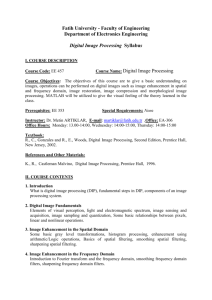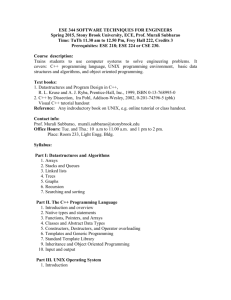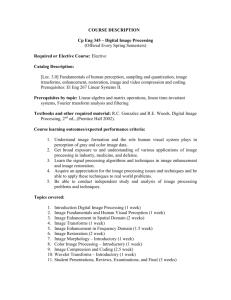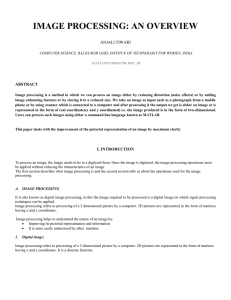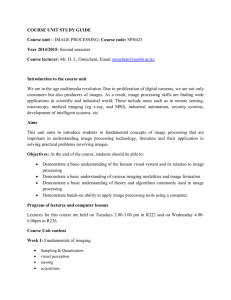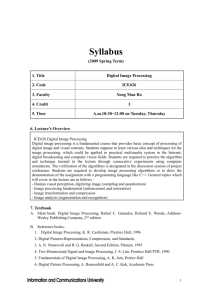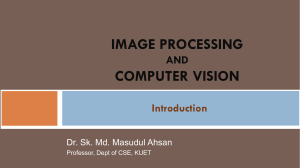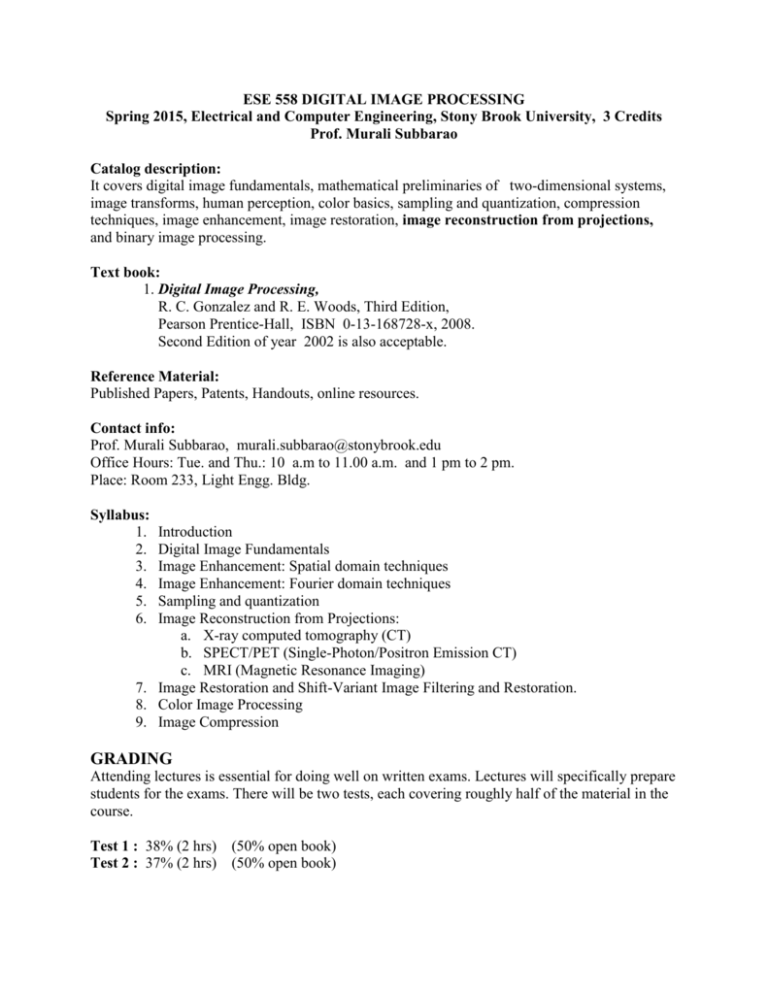
ESE 558 DIGITAL IMAGE PROCESSING
Spring 2015, Electrical and Computer Engineering, Stony Brook University, 3 Credits
Prof. Murali Subbarao
Catalog description:
It covers digital image fundamentals, mathematical preliminaries of two-dimensional systems,
image transforms, human perception, color basics, sampling and quantization, compression
techniques, image enhancement, image restoration, image reconstruction from projections,
and binary image processing.
Text book:
1. Digital Image Processing,
R. C. Gonzalez and R. E. Woods, Third Edition,
Pearson Prentice-Hall, ISBN 0-13-168728-x, 2008.
Second Edition of year 2002 is also acceptable.
Reference Material:
Published Papers, Patents, Handouts, online resources.
Contact info:
Prof. Murali Subbarao, murali.subbarao@stonybrook.edu
Office Hours: Tue. and Thu.: 10 a.m to 11.00 a.m. and 1 pm to 2 pm.
Place: Room 233, Light Engg. Bldg.
Syllabus:
1.
2.
3.
4.
5.
6.
Introduction
Digital Image Fundamentals
Image Enhancement: Spatial domain techniques
Image Enhancement: Fourier domain techniques
Sampling and quantization
Image Reconstruction from Projections:
a. X-ray computed tomography (CT)
b. SPECT/PET (Single-Photon/Positron Emission CT)
c. MRI (Magnetic Resonance Imaging)
7. Image Restoration and Shift-Variant Image Filtering and Restoration.
8. Color Image Processing
9. Image Compression
GRADING
Attending lectures is essential for doing well on written exams. Lectures will specifically prepare
students for the exams. There will be two tests, each covering roughly half of the material in the
course.
Test 1 : 38% (2 hrs) (50% open book)
Test 2 : 37% (2 hrs) (50% open book)
Individual Programming Project: 15%.
Matlab/Mathematica/Octave programming language should be learned for completing the
project. Project is not difficult and requires about 12 hours of effort.
Student Presentation: 10%.
Each student will read a published paper on a medical imaging topic and present it to class. You
will need to prepare around 15 slides and present it for 15 minutes. Estimated effort: about 12
hours.
Grades are assigned based on absolute percentage of total marks as below.
This policy is subject change.
A : 91—100 , A- : 86—90 , B+ : 81—85, B : 76—80, B- : 71--75
C+ : 68—70, C : 64—67, C- : 61—63, D+ : 56—60, D : 51—55, F : 0—50
Course Objectives:
Students will learn:
1. The fundamentals of digital image formation and the nature and structure of digital
image data.
2. The mathematical basis and computational algorithms for image enhancement and
filtering in the spatial domain and the Fourier domain.
3. The techniques for optimal sampling, quantization, restoration, and compression of
image data.
4. The mathematical basis and computational algorithms for X-ray computed tomography.
5. The development of software for implementing image processing algorithms.
Course Outcomes:
Students will acquire an ability to analyze, design, and implement digital image processing
algorithms in software for:
1. Image enhancement and filtering in the spatial and Fourier domains.
2. Image restoration in the presence of noise in the spatial and Fourier domains.
3. Three-dimensional image reconstruction from projections in X-ray computed
tomography.
4. Image compression and decompression.


